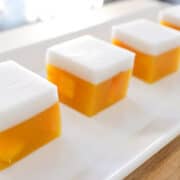Ingredients
Mango Layer
- 250 g mango flesh (for purée), roughly cubed (from about 1 ½ - 2 mangos, scant 2 cups)
- Flesh of 1 mango, 1-cm cubes
- ½ cup orange juice
- 1 ¼ cups water
- 2 tsp (5.2 g) agar agar powder (see note)
- ⅓ cup sugar
- Lime juice, to taste
- 15 small mint leaves, optional
Coconut Layer
- ⅔ cup water
- 1 tsp (2.6 g) agar agar powder (see note)
- 4 Tbsp sugar
- 1/8 tsp salt
- ⅔ cup coconut milk
Instructions
For the mango layer:
In a blender, blend the mango cubes (for the purée) and orange juice until smooth. In a small pot, add water and agar agar powder and stir to distribute the powder. Bring to a full boil, stirring frequently, making sure that all the agar agar powder has dissolved. Add sugar and mango purée and whisk until smooth. Remove from the heat and taste, adding more sugar and/or lime juice as needed.
Pour the mango mixture into a mould. You can use whatever mould you like; I used a square pan, but you can also make individual ones using cups, glasses, etc. Add the 1-cm mango cubes into the mango base, distributing the cubes evenly throughout, and pushing them down to make sure they are submerged. If desired, you can add mint leaves as well, pushing them into the mango base. Note: Agar agar jelly sets at room temperature, so work quickly especially if you are making small ones.
Let the jelly set until the surface is firm enough to pour on the next layer (if you touch it gently and your fingers are not poking through, it's ready). You CAN put it in the fridge to make it go faster, but do not let this get cold! (see note)
For the coconut layer:
In a small pot, combine water and agar agar powder and stir to distribute the powder. Bring to a full boil, stirring frequently, making sure that all the agar agar powder has dissolved. Add sugar, salt, and stir until dissolved. Add coconut milk, stir to mix and remove from heat. You can use this immediately if the mango layer has set, if the mango layer has not set, keep this mixture hot, covered, over the lowest heat setting on the stove to prevent it from setting and becoming clumpy.
Once the surface of the mango layer has set, gently pour the coconut layer over the back of a spoon on to the mango base (if you pour too hard it will break or cause dents in the mango layer). Refrigerate for a few hours until cold.
Close to serving time, cut into cubes with a sharp knife and enjoy!
Important Note on Unmolding: Do not unmold or cut agar jelly until close to serving time. When agar jelly is uncontained, water will slowly seep out because it's an unstable gel. A small amount of water loss will not affect how it tastes, and if it has to sit for a couple of hours unmolded that's fine, but you want to avoid it when possible. If you want to give it away to people, I recommend making it in clear heat-proof plastic or glass cups that you're willing to part with.
Notes
Make sure you're buying pure agar agar powder with no sugar or any other ingredients added (you'll need to check the ingredient list.) Also if measuring by volume, you'll need to use agar agar POWDER. If using flakes, use the weight in grams.
A few people have reported that their coconut layer is not sticking to the mango layer and it slides off when cut. This happens because the bottom layer has set too cold, and the top layer isn't hot enough. The layers will stick when the heat from the coconut mixture dissolves a tiny bit of the surface of the mango layer. So if the bottom layer is too cold and/or the top layer isn't hot enough, they won't stick together. See my coffee agar jelly video where I talk more about this.
